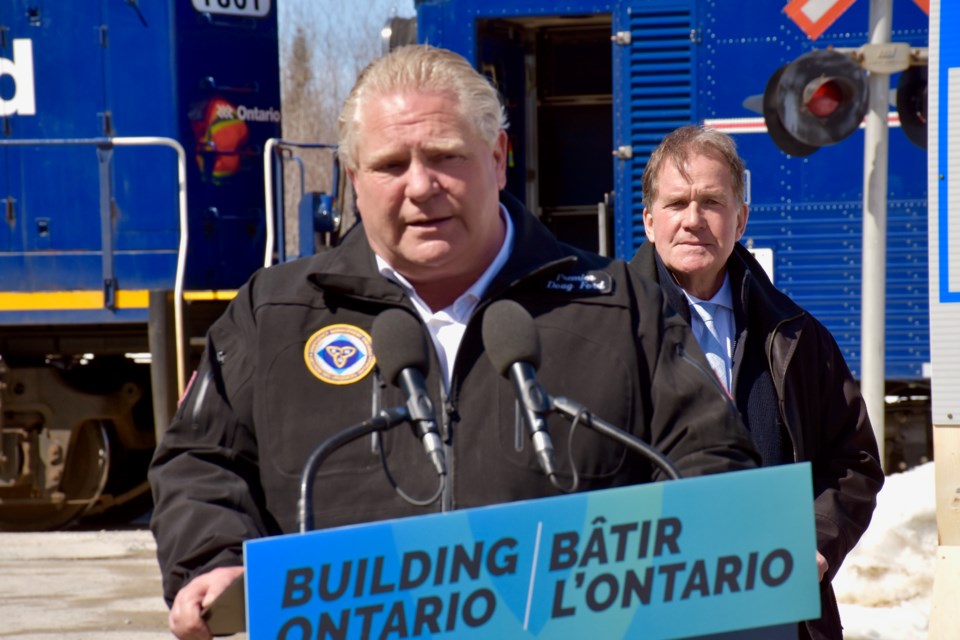Ontario is committing an additional $75 million to bring back passenger train service in Northern Ontario.
The business case for the passenger service has also been updated. It takes a closer look at three options for the train, all of which would require a subsidy to sustain operations. Two of the rail lines being explored end in Timmins.
Premier Doug Ford was in Timmins today for the funding announcement. Ford, Minister of Transportation Caroline Mulroney, Timmins Mayor George Pirie, Ontario Northland president and CEO Corina Moore and other officials boarded a passenger train in Hoyle to make the short trip to Porcupine, where a new terminal station could be located.
“Restoring this rail service will be a huge boost, not only for families up here but also to local tourism operators who will once again be able to show the world the type of beauty that is only found in Northern Ontario,” said Ford.
Over the next three years, Moore said the funding will allow ONTC to look at all the requirements such as passenger coaches and infrastructure needed for the rail service. Agreements would also have to be negotiated with CN Railway.
“We know what the infrastructure upgrades need to look like, so we’re going to start on that planning. We’re looking at station requirements and all the other opportunities along the way to make sure this attracts tourism and connects people the way it should across the north,” said Moore.
Passenger rail service was cancelled in Northern Ontario in 2012. At that time the train service did not run into Timmins and was a Toronto to Cochrane line.
In 2018, Premier Doug Ford made a campaign promise to restore passenger rail service. The government announced plans to return passenger train service to the north and committed $5 million for feasibility work in 2021. Timmins has been named as a terminal site. The goal is to have passenger rail service operating in the mid-2020s.
The revised business case takes a more detailed look at three options for the passenger rail route.
The option to end the service in North Bay has been removed and there's a new option to end the train service in Timmins but provide a train connection to Cochrane. Two new proposed stations have also been added for Kirkland Lake (Swastika) and South River. North of North Bay, the stations already confirmed are Temagami, New Liskeard, Englehart and Matheson.
The three routes being looked at are:
- Option 1: Train service from Toronto to Timmins, with an express bus route between Matheson and Cochrane, and a bus connection between Timmins and Cochrane. The estimate is the ridership would be 39,170 to 58,360 by 2041. The total cost, including the one-time capital costs to start and ongoing operating and maintenance costs, is $554.7 million to $671.3 million for a new fleet and $440.1 million to $630.2 million for a refurbished fleet.
- Option 2: Train service from Toronto to Timmins, with an additional rail connection between Timmins and Cochrane, and an express bus between Matheson and Cochrane. The estimate is the ridership would be 39,220 to 60,110 by 2041. The total cost, including the one-time capital costs to start and ongoing operating and maintenance costs, is $552.7 million to $666.2 million for a new fleet and $438.3 million to $625 million for a refurbished fleet.
- Option 3: Train service to Cochrane (where the Polar Bear Express train from Moosonee ends), an express bus between Matheson and Timmins, and a bus connection between Timmins and Cochrane. The estimate is the ridership would be 39,790 to 55,090 by 2041. The total cost, including the one-time capital costs to start and ongoing operating and maintenance costs, is $552.2 million to $649.1 million for a new fleet and $427.7 million to $653.2 million for a refurbished fleet.
The frequency of the train would be based on season demands and range from four to seven days a week.
All of the options require a subsidy to sustain the service. The business report notes that an operating subsidy is typical for inter-community projects in North America that connect underserved areas. By 2041, the conservative scenario pegs the annual subsidy between $11.8 million and $12.6 million.
The updated business case says option two which ends in Timmins and also connects Cochrane by rail "outperforms" other options with its economic and cost-ration benefits.
Pirie said returning passenger rail is imperative to the region's growth and prosperity.
"As a regional hub and with Porcupine as the future terminus location, we will most certainly see positive impact on our tourism and industry sectors,” he said in a news release.
"Residents will have another viable travel option to Toronto and points south. This is imperative for access to medical appointments and travel. It will improve our quality of life and the well-being of the community by strengthening access to and from Timmins and the north.”
The next Ontario election is June 2. In Timmins, Pirie is the PC candidate.
